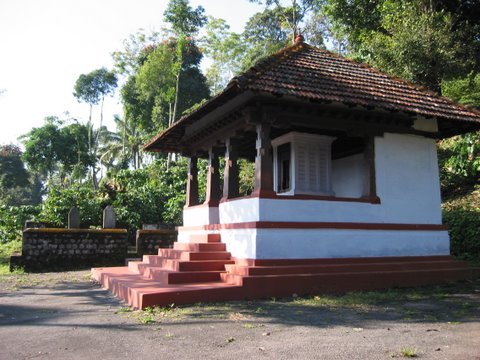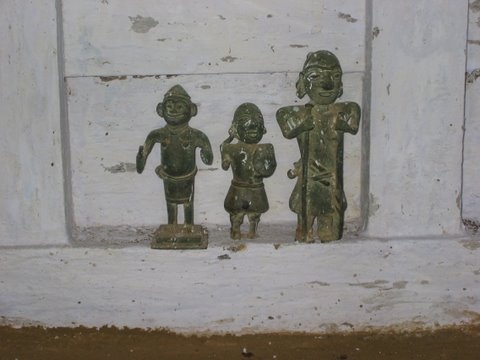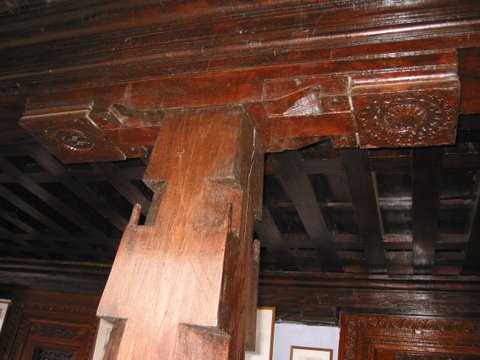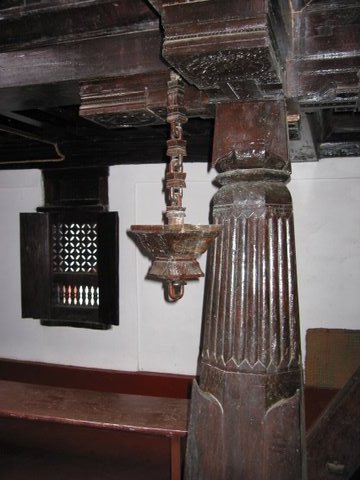
Click to enlarge
Click to enlarge
Click to enlarge
Click to enlarge
Click to enlarge
Click to enlarge
Click to enlarge
Naḍikērianḍa-1 |
Quick Facts |
|
| Number of members in the okka | About 250 (about 75 families), none of whom resides in the ainmane; one (a bachelor) lives in the house at the back. (A Nambiyappanda woman and her two children live in the ale pore now.) | |
| Location – village | Karaḍa. | |
| Age | About 200 years old. It was renovated in 1996 and in 2002. (The house at the rear, built by Nanjappajja is about 150 years old). | |
| Community | Kodava. |
| Date visited | 5 Nov 2003, 23 Feb 2005, 24 Nov 2009. |
| Location – village | Karaḍa. |
| Type of ainmane | Large mund mane, with two roofs. A stone-paved narrow lane leads up a steep slope from the road below to the kaimada to the left and then, up rough stone steps, to the arched bakka pore entrance and the large stone-paved yard in front of the ainmane. The ale pore extends on both sides of the bakka pore entrance. The part to the left (which used to be a stable in the past) has rooms downstairs and a hall upstairs, built in the memory of Dr.Subbiah who died young in a hunting accident in 1935, shot by his friend. (It cost Rs.1200, according to the minutes of the General Body meeting of that year). In the past, the part to the right of the bakka pore was a cow-shed with a pathaya upstairs, with wooden slatted walls. When renovated in 2002, the cow-shed was converted into a dining hall and the pathaya was replaced by a large meeting hall. There are thombe kann on all the four outer walls of the ainmane. Two small wooden boxes (gud-potti) with shutters are embedded in the western wall of the verandah. (They are empty now - no-one knows what they were used for.) Some of the old pillars in the mund that were rotting were replaced with newly carved ones in 1996. The nellakki has a beautiful old, simple hanging lamp near the north-west corner of the mund, and a wooden bhasma kutt near the south-east corner. [‘Silent Sentinels’ – The Traditional Architecture of Coorg’, The HECAR Foundation, 2005, has architectural drawings and details of the ainmane.] |
| Direction facing | East. |
| Kall boti | Yes. A mask was tied to it during a recent Karana there (see photo). |
| Age | About 200 years old. It was renovated in 1996 and in 2002. (The house at the rear, built by Nanjappajja is about 150 years old). |
| Original ainmane? | No, it is the second. The first one and the old kaimada were to the south-west of the present ainmane, at a higher level, even higher than the current kala and car park there. |
| Woodwork | There are two feet wide wooden aimaras on three sides of the verandah (all except the northern side) and around the mund. The verandah has solid pillars with beautiful carved capitols on its eastern side as well as along its inner (western) wall. The door-frame as well as the window-frame and wooden screen in the window of the verandah are carved with geometrical designs (see photo). The mund has fluted pillars (see photo) except for the kanni kamba in the south-west corner, which has simple flowers etched on it. The kanni kamba is a new one, replacing the old carved pillar there that was rotting. All the pillars have carvings on their capitols. The doors to the kitchen and to some of the rooms around the nellakki also have carved door-frames. |
| Electricity in the ainmane | Yes. |
| Telephone in the ainmane | No. |
| Kanni kamba | Pillar in the south-west corner of the mund. |
| Kanni kombare | Narrow wood-panelled room in the south-west corner of the house, with the entrance door from the adjacent room to its east. There is a long shelf on its western wall to keep the sacred lamp and meedi. |
| Floor | Fully cemented in 1976. |
| Roof | Tiled long ago. No one remembers when. |
| Number of rooms | Ten (including the kitchen and kanni kombare). |
| Attic | Large hall around the mund with only wooden benches kept there. The staircase is from the nellakki. |
| Kaimada | The present one is the second kaimada (see photo), built at the same time as the ainmane. Meedi is kept here during Karanang kodpa and on other auspicious occasions. The kaimada faces east and is located in a small open yard close to the bakka pore, at a lower level. It has wide cement steps, a low wicket gate to the central gudi, and four carved pillars and aimaras in front, with beautiful lotuses carved on the capitols. The raised gudi is enclosed with wooden slatted walls and has a beautiful carved door in front. Inside the gudi are three images of ancestors embossed on metal (see photo). In an open walled enclosure to the south of the kaimada are three tombstones to famous people in the okka. (The foundation of the earlier kaimada can be seen high up, to the south-west of the house - a raised platform with stones along its border, and a tomb nearby with crumbling cement plaster. Offerings are made there during Puthari and Karana there.) |
| Al rupa | No. |
| Temples/shrines nearby | Karada Bhagavathi temple (where the Bolak namme is held, mid April). Malethirike shrine to Male Thambiran up the hill nearby (where the namme is held on March 14). |
| Festivals celebrated in the ainmane | Karana there is held in April/May when all members of the okka get together (see There/Kola below). Karanang kodpa (a very simple ritual which only those near the ainmane attend). Puthari. |
| Number of members in the okka | About 250 (about 75 families), none of whom resides in the ainmane; one (a bachelor) lives in the house at the back. (A Nambiyappanda woman and her two children live in the ale pore now.) |
| Book on the okka and Family Tree | No book - only the ballad of Nadikerianda Devayya in the Pattole Palame. The Family Tree was first drawn in 1918 by N.A.Chinnappa (author of the Pattole Palame), and updated in 1975 by his son, N.C.Subbayya. It was updated again in 2001 by Saroj and Appaji Nanjappa and Rana Nanjappa, and traces the okka back 11 generations to Karanava Ayyanna. (Nadikerianda-2, the Palangala bhaga that broke away, has a Family Tree for that bhaga, drawn in 2008.). (We have copies of the Family Trees for both the Nadikerianda bhagas). |
| Name of Karanava: | Ayyanna who is believed to have lived in the 1600s. N.A.Chinnappa says that there is no evidence to show how much older Devayya, the hero of the ballad of Nadikerianda Devayya, was than Ayyanna. |
| Name of Aruva okka | Ithichanda (mutual) |
| Thakkame rights of the okka | Ur thakka for Karada and Deva thakka of the Malethirike shrine in Karada (the latter, along with the Chottalyammanda Amma okka).. |
| Pattedara | N.C. Poovaiah (in Siddapur). |
| President of the okka | N.S.Chinnappa (Bangalore). The General Body meets twice annually, at Puthari and during the Bolak namme at the Bhagavathi temple. The Family fund is used for festival expenses, sports, education, maintenance of the ainmane etc. |
| Mand nearby | The ur mand is Koliyare mand (nearby, across the road) and the nad mand is Beliyane mand (by the side of the main road). |
| Ambala nearby | By the road-side near the Chottalyammanda house, on the way to the Malethirike shrine. |
| Deva kaad nearby | Dedicated to Bhagavathi, near the temple (nine acres). |
| Thutengala of the okka | It is across the road, in the forest in front of the ainmane. Note: There is another graveyard for the Nadikeriandas in Madikeri, where Bose Mandanna’s parents are buried. This was set aside in land owned by Nadikeranda Appacha, son of Monnappa Ajja, who owned a lot of land in Madikeri. (Appacha also gifted land for graveyards to the families of his two sisters – Konganda and Codanda). |
| Year when last wedding held in the ainmane | 1985, when the weddings of two brothers N. K. Nanayya (Jappu) and N.K. Chengappa (Dilip) were held simultaneously. |
| There/Kola in the ainmane | Karana there is an elaborate two-day affair, celebrated annually in April/May by one of the kades of the okka taking turns (therige) to conduct it. Seven theres are held through the night, the first four in the evening and the other three the next day, starting very early in the morning. They are held in the following order: Kuttichatha (a spirit-deity), Karajjappa (who killed a tiger), Nari (tiger who fights a young man and dies), Kuliya (spirit-deity who embraces one of the young men there and has a baby – a figure made of straw is used to depict it), Vishnu-murthi (Narasimha with a lion’s mask), eth (ox killed by a tiger), and Ajjappa (Karanava – the last and longest there, when the one possessed by the Karanava answers questions put to him by members of the okka and advises them). The theres are performed by Bannas |
| Folksongs sung in the ainmane | Not since about 40 to 50 years ago (when members sang with villagers in the mund). |
| Singers of folk songs in the okka | N.P. Kalappa (Ravi). |
| Paintings/drawings on walls | Have not heard of it. |
| Kadanga nearby | Only small ones between land belonging to this okka and to that of others in the village. |
| Stories related to okka name |
|
| Stories related to the okka |
where they themselves settled. That is why they are referred to as Nayamma (which means Nair) Nadikeriya in the village and in folk songs. There is a field in Palangala that is called Nayamma nadu bail. [Source: Notes written by N.A. Chinnappa, author of the Pattole Palame].
|
Chinshai Technologies | Ainmanes Copyright 2011. All right reserved






